Irreversibility Interpretation and MHD Mixed Convection of Hybrid Nanofluids in a 3D Heated Lid-Driven Chamber
Abstract
:1. Introduction
2. Mathematical Model and the Study Configuration
2.1. Mathematical Model
- Dynamic viscosity: ;
- Density: ;
- Specific heat: ;
- Thermal expansion coefficient: ,
- Electrical conductivity:; and
- Thermal conductivity: .
2.2. Boundary Conditions
| Thermal Condition | Velocity Condition | |
| The left wall | ||
| The right wall | ||
| The top wall | adiabatic | |
| The lower wall |
2.3. The Total Entropy Generation
3. Numerical Method and Validation
4. Results and Discussion
5. Conclusions
- Increasing the speed of the horizontal displacement of the upper wall or the permeability of the chamber accelerates the movement of the flow within the room and improves heat transfer.
- Applying the magnetic field and gradually increasing its intensity hinders the movement of the flow particles, and thus negatively affects the thermal transfer.
- The concentration of the total entropy generation depends mainly on the value of the Reynolds number. As the Re value increases, the entropy generation shifts downward.
- The mean value of the number (Nu) is more significant for N = 4 in the case where the natural convection is predominant and for N = 2 in the case where the forced convection is predominant.
Author Contributions
Funding
Institutional Review Board Statement
Informed Consent Statement
Data Availability Statement
Conflicts of Interest
References
- Mustafa, M.A.S.; Hussain, H.M.; Abtan, A.A.; Habeeb, L.J. Review on Mixed Convective Heat Transfer in Different Geometries of Cavity with Lid Driven. J. Mech. Eng. Res. Dev. 2020, 43, 12–25. [Google Scholar]
- Koulali, A.; Sahi, A.; Meziani, B.; Aissa, A.; Sadaoui, D.; Ali, H.M. CFD analysis of natural convection between two superposed fluids: Role of corrugated bottoms. Chem. Eng. Commun. 2021, 1–17. [Google Scholar] [CrossRef]
- Ahmed, S.E.; El-Aziz, A. Effect of local thermal non-equilibrium on unsteady heat transfer by natural convection of a nanofluid over a vertical wavy surface. Meccanica 2013, 48, 33–43. [Google Scholar] [CrossRef]
- Rasool, G.; Saeed, A.M.; Lare, A.I.; Abderrahmane, A.; Guedri, K.; Vaidya, H.; Marzouki, R. Darcy-Forchheimer Flow of Water Conveying Multi-Walled Carbon Nanoparticles through a Vertical Cleveland Z-Staggered Cavity Subject to Entropy Generation. Micromachines 2022, 13, 744. [Google Scholar] [CrossRef]
- Korei, Z.; Benissaad, S.; Berrahil, F.; Filali, A. MHD mixed convection and irreversibility analysis of hybrid nanofluids in a partially heated lid-driven cavity chamfered from the bottom side. Int. Commun. Heat Mass Transf. 2022, 132, 105895. [Google Scholar] [CrossRef]
- Zhang, H.; Nie, X.; Bokov, D.O.; Toghraie, D.; Akbari, O.A.; Montazerifar, F.; Pourfattah, F.; Esmaeili, Y.; Khodaparast, R. Numerical study of mixed convection and entropy generation of Water-Ag nanofluid filled semi-elliptic lid-driven cavity. Alex. Eng. J. 2022, 61, 8875–8896. [Google Scholar] [CrossRef]
- Wang, A.-Y.; Xu, H. Highly accurate wavelet-homotopy solutions for mixed convection hybrid nanofluid flow in an inclined square lid-driven cavityImage 1. Comput. Math. Appl. 2022, 108, 88–108. [Google Scholar] [CrossRef]
- Jakeer, S.; Reddy, P.B.; Rashad, A.M.; Nabwey, H.A. Impact of heated obstacle position on magneto-hybrid nanofluid flow in a lid-driven porous cavity with Cattaneo-Christov heat flux pattern. Alex. Eng. J. 2021, 60, 821–835. [Google Scholar] [CrossRef]
- Manchanda, M.; Gangawane, K.M. Mixed convection in a two-sided lid-driven cavity containing heated triangular block for non-Newtonian power-law fluids. Int. J. Mech. Sci. 2018, 144, 235–248. [Google Scholar] [CrossRef]
- Izadi, S.; Armaghani, T.; Ghasemiasl, R.; Chamkha, A.J.; Molana, M. A comprehensive review on mixed convection of nanofluids in various shapes of enclosures. Powder Technol. 2019, 343, 880–907. [Google Scholar] [CrossRef]
- Zhou, W.; Yan, Y.; Xie, Y.; Liu, B. Three dimensional lattice Boltzmann simulation for mixed convection of nanofluids in the presence of magnetic field. Int. Commun. Heat Mass Transf. 2017, 80, 1–9. [Google Scholar] [CrossRef]
- M’hamed, B.; Sidik, N.A.C.; Yazid, M.N.A.W.M.; Mamat, R.; Najafi, G.; Kefayati, G.H.R. A review on why researchers apply external magnetic field on nanofluids. Int. Commun. Heat Mass Transf. 2016, 78, 60–67. [Google Scholar] [CrossRef] [Green Version]
- Bakar, N.A.; Roslan, R.; Karimipour, A. Magnetic Field Effect on Mixed Convection Heat Transfer in a Lid-Driven Rectangular Cavity. CFD Lett. 2020, 12, 13–21. [Google Scholar]
- Khanafer, K.; Aithal, S.M. Mixed convection heat transfer in a lid-driven cavity with a rotating circular cylinder. Int. Commun. Heat Mass Transf. 2017, 86, 131–142. [Google Scholar] [CrossRef]
- Ali, M.M.; Akhter, R.; Alim, M.A. Magneto-mixed convection in a lid driven partially heated cavity equipped with nanofluid and rotating flat plate. Alex. Eng. J. 2022, 61, 257–278. [Google Scholar] [CrossRef]
- Ghasemi, K.; Siavashi, M. Three-dimensional analysis of magnetohydrodynamic transverse mixed convection of nanofluid inside a lid-driven enclosure using MRT-LBM. Int. J. Mech. Sci. 2020, 165, 105199. [Google Scholar] [CrossRef]
- Geridonmez, B.P.; Oztop, H.F. Mixed Convection Heat Transfer in a Lid-Driven Cavity under the Effect of a Partial Magnetic Field. Heat Transf. Eng. 2020, 42, 875–887. [Google Scholar] [CrossRef]
- Hussain, S.; Jamal, M.; Geridonmez, B.P. Impact of fins and inclined magnetic field in double lid-driven cavity with Cu–water nanofluid. Int. J. Therm. Sci. 2021, 161, 106707. [Google Scholar] [CrossRef]
- Gutt, R.; Groşan, T. On the lid-driven problem in a porous cavity. A theoretical and numerical approach. Appl. Math. Comput. 2015, 266, 1070–1082. [Google Scholar] [CrossRef]
- Çolak, E.; Ekici, Ö.; Öztop, H.F. Mixed convection in a lid-driven cavity with partially heated porous block. Int. Commun. Heat Mass Transf. 2021, 126, 105450. [Google Scholar] [CrossRef]
- Astanina, M.S.; Sheremet, M.A.; Oztop, H.F.; Abu-Hamdeh, N. Mixed convection of Al2O3-water nanofluid in a lid-driven cavity having two porous layers. Int. J. Heat Mass Transf. 2018, 118, 527–537. [Google Scholar] [CrossRef]
- Wang, L.; Wang, W.-W.; Cai, Y.; Liu, D.; Zhao, F.-Y. Effects of porous fins on mixed convection and heat transfer mechanics in lid-driven cavities: Full numerical modeling and parametric simulations. Trans. Porous Media 2020, 132, 495–534. [Google Scholar] [CrossRef]
- Ataei-Dadavi, I.; Chakkingal, M.; Kenjeres, S.; Kleijn, C.R.; Tummers, M.J. Experiments on mixed convection in a vented differentially side-heated cavity filled with a coarse porous medium. Int. J. Heat Mass Transf. 2020, 149, 119238. [Google Scholar] [CrossRef]
- Yapici, K.; Obut, S. Laminar mixed-convection heat transfer in a lid-driven cavity with modified heated wall. Heat Transf. Eng. 2015, 36, 303–314. [Google Scholar] [CrossRef]
- Oğlakkaya, F.S.; Bozkaya, C. Unsteady MHD mixed convection flow in a lid-driven cavity with a heated wavy wall. Int. J. Mech. Sci. 2018, 148, 231–245. [Google Scholar] [CrossRef]
- Nasrin, R. Influences of physical parameters on mixed convection in a horizontal lid-driven cavity with an undulating base surface. Numer. Heat Transf. Part A Appl. 2012, 61, 306–321. [Google Scholar] [CrossRef]
- Benzema, M.; Benkahla, Y.K.; Labsi, N.; Brunier, E.; Ouyahia, S.-E. Numerical mixed convection heat transfer analysis in a ventilated irregular enclosure crossed by Cu–water nanofluid. Arab. J. Sci. Eng. 2017, 42, 4575–4586. [Google Scholar] [CrossRef]
- Ali, A.M.; Angelino, M.; Rona, A. Numerical analysis on the thermal performance of microchannel heat sinks with Al2O3 nanofluid and various fins. Appl. Therm. Eng. 2021, 198, 117458. [Google Scholar] [CrossRef]
- Alnaqi, A.A.; Alsarraf, J.; Al-Rashed, A.A.A.A.; Afrand, M. Thermal-hydraulic analysis and irreversibility of the MWCNTs-SiO2/EG-H2O non-Newtonian hybrid nanofluids inside a zigzag micro-channels heat sink. Int. Commun. Heat Mass Transf. 2021, 122, 105158. [Google Scholar] [CrossRef]
- Medebber, M.A.; Aissa, A.; Slimani, M.E.A.; Retiel, N. Numerical study of natural convection in vertical cylindrical annular enclosure filled with Cu-water nanofluid under magnetic fields. In Defect and Diffusion Forum; Trans Tech Publications Ltd.: Freienbach, Switzerland, 2019; pp. 123–137. [Google Scholar]
- Abderrahmane, A.; Qasem, N.A.A.; Younis, O.; Marzouki, R.; Mourad, A.; Shah, N.A.; Chung, J.D. MHD Hybrid Nanofluid Mixed Convection Heat Transfer and Entropy Generation in a 3-D Triangular Porous Cavity with Zigzag Wall and Rotating Cylinder. Mathematics 2022, 10, 769. [Google Scholar] [CrossRef]
- Al-Kouz, W.; Bendrer, B.A.-I.; Aissa, A.; Almuhtady, A.; Jamshed, W.; Nisar, K.S.; Mourad, A.; Alshehri, N.A.; Zakarya, M. Galerkin finite element analysis of magneto two-phase nanofluid flowing in double wavy enclosure comprehending an adiabatic rotating cylinder. Sci. Rep. 2021, 11, 1–15. [Google Scholar] [CrossRef] [PubMed]
- Ahmed, S.E. Caputo fractional convective flow in an inclined wavy vented cavity filled with a porous medium using Al2O3-Cu hybrid nanofluids. Int. Commun. Heat Mass Transf. 2020, 116, 104690. [Google Scholar] [CrossRef]
- Slimani, R.; Aissa, A.; Mebarek-Oudina, F.; Khan, U.; Sahnoun, M.; Chamkha, A.J.; Medebber, M.A. Natural convection analysis flow of Al2O3-Cu/water hybrid nanofluid in a porous conical enclosure subjected to the magnetic field. Eur. Phys. J. Appl. Phys. 2020, 92, 10904. [Google Scholar] [CrossRef]
- Mansour, M.A.; Ahmed, S.E. Mixed convection flows in a square lid-driven cavity with heat source at the bottom utilising nanofluid. Can. J. Chem. Eng. 2012, 90, 100–110. [Google Scholar] [CrossRef]
- Takabi, B.; Salehi, S. Augmentation of the heat transfer performance of a sinusoidal corrugated enclosure by employing hybrid nanofluid. Adv. Mech. Eng. 2014, 6, 147059. [Google Scholar] [CrossRef]
- Elshehabey, H.M.; Raizah, Z.; Öztop, H.F.; Ahmed, S.E. MHD natural convective flow of Fe3O4−H2O ferrofluids in an inclined partial open complex-wavy-walls ringed enclosures using non-linear Boussinesq approximation. Int. J. Mech. Sci. 2020, 170, 105352. [Google Scholar] [CrossRef]
- Hussain, S.; Ahmed, S.E. Unsteady MHD forced convection over a backward facing step including a rotating cylinder utilizing Fe3O4-water ferrofluid. J. Magn. Magn. Mater. 2019, 484, 356–366. [Google Scholar] [CrossRef]
- Abderrahmane, A.; Hatami, M.; Medebber, M.A.; Haroun, S.; Ahmed, S.E.; Mohammed, S. Non-Newtonian nanofluid natural convective heat transfer in an inclined Half-annulus porous enclosure using FEM. Alex. Eng. J. 2022, 61, 5441–5453. [Google Scholar] [CrossRef]
- Bendrer, B.; Abderrahmane, A.; Ahmed, S.E.; Raizah, Z.A. 3D magnetic buoyancy-driven flow of hybrid nanofluids confined wavy cubic enclosures including multi-layers and heated obstacle. Int. Commun. Heat Mass Transf. 2021, 126, 105431. [Google Scholar] [CrossRef]
- Al-Kouz, W.; Medebber, M.A.; Elkotb, M.A.; Abderrahmane, A.; Aimad, K.; Al-Farhany, K.; Jamshed, W.; Moria, H.; Aldawi, F.; Saleel, C.A.; et al. Galerkin finite element analysis of Darcy–Brinkman–Forchheimer natural convective flow in conical annular enclosure with discrete heat sources. Energy Rep. 2021, 7, 6172–6181. [Google Scholar] [CrossRef]
- Iwatsu, R.; Hyun, J.M.; Kuwahara, K. Mixed convection in a driven cavity with a stable vertical temperature gradient. Int. J. Heat Mass Transf. 1993, 36, 1601–1608. [Google Scholar] [CrossRef]
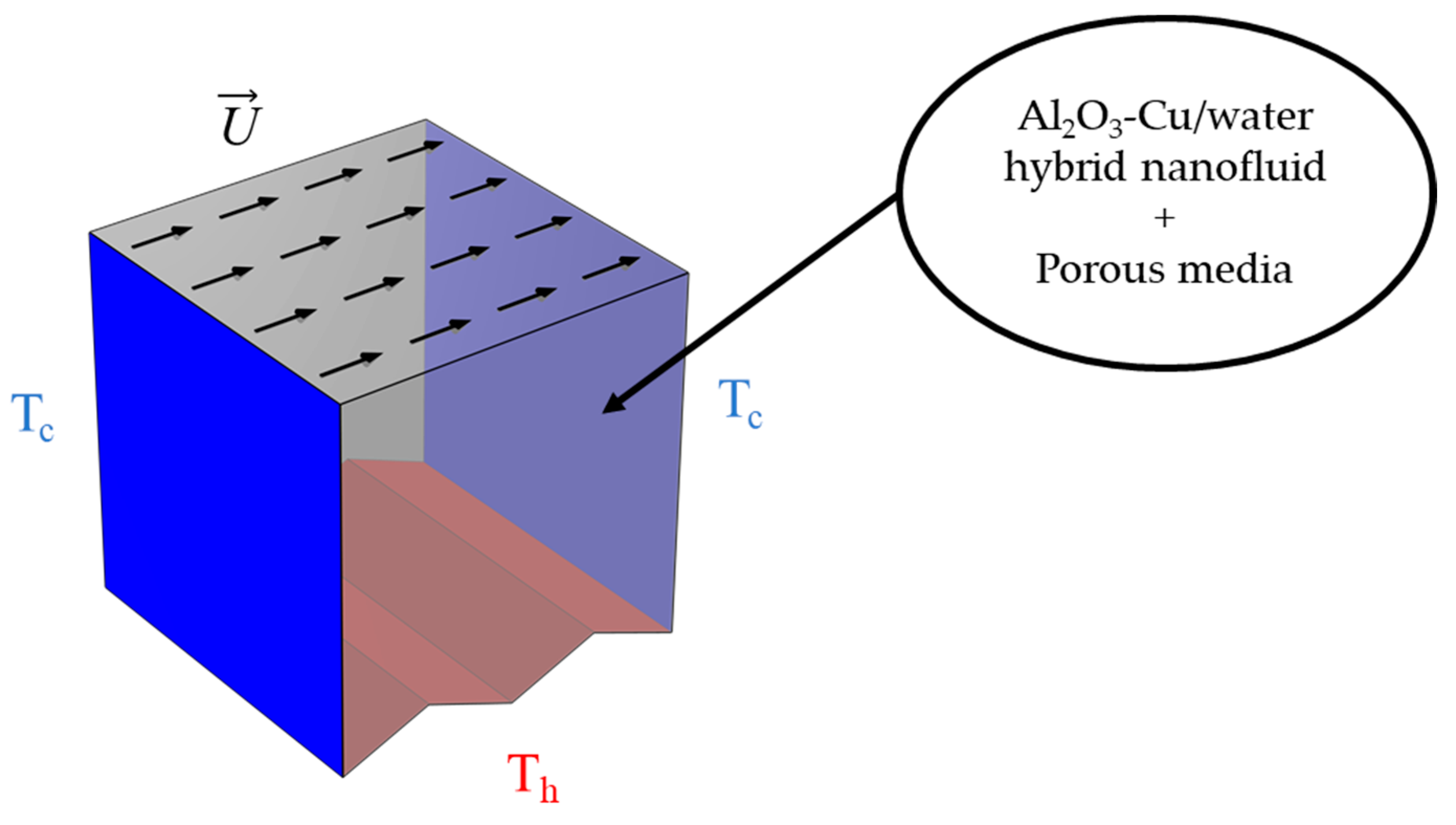
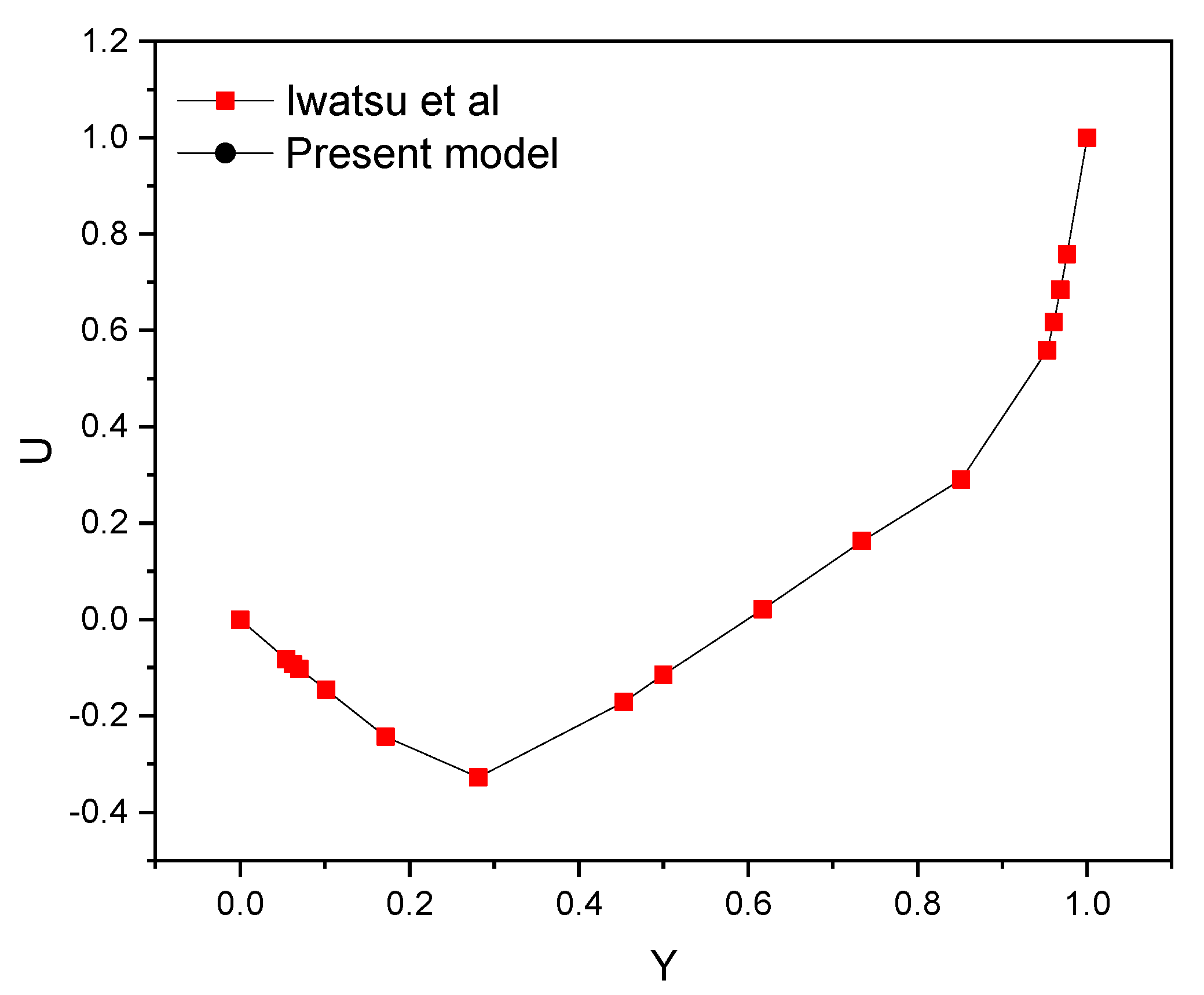
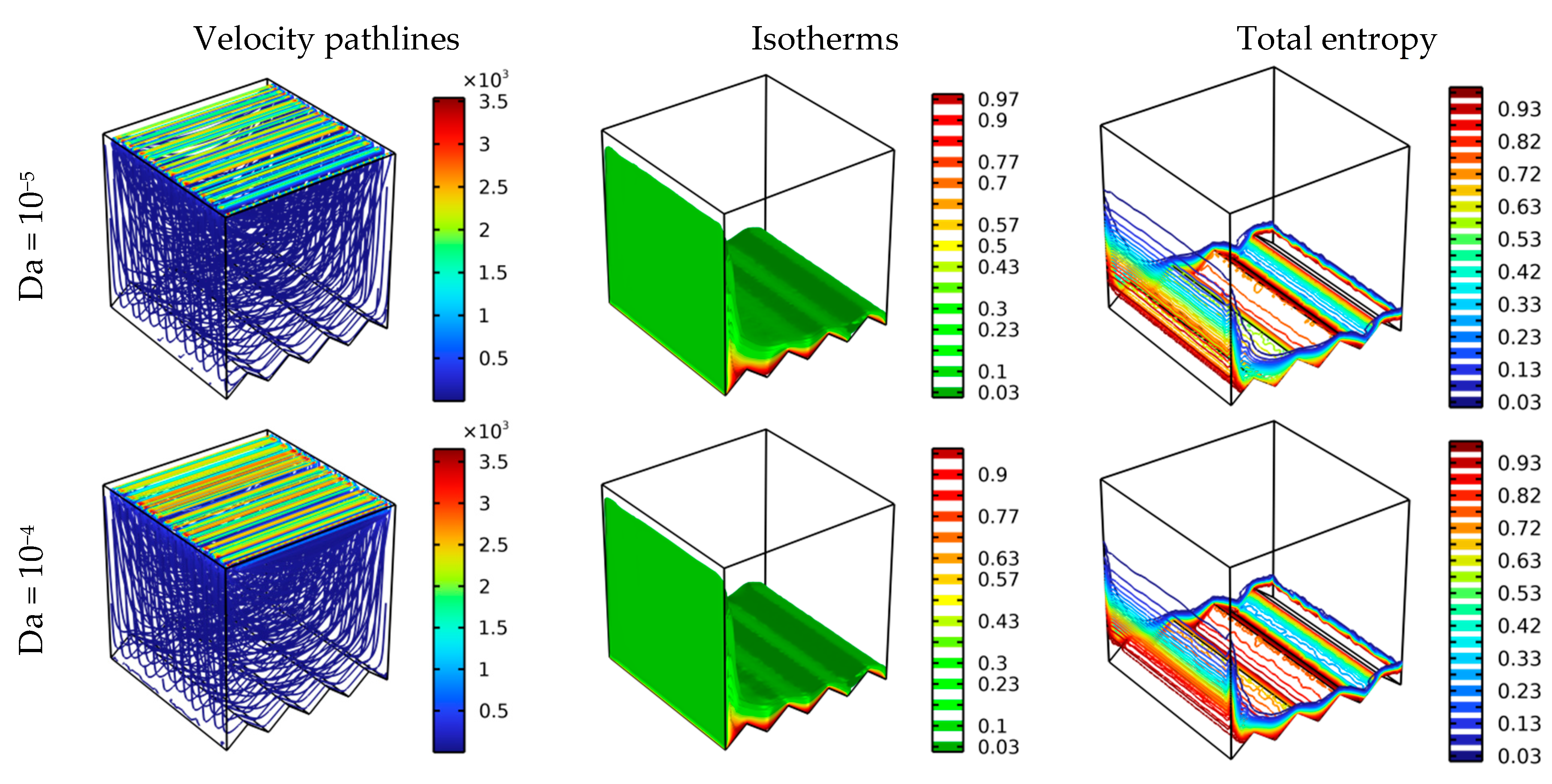

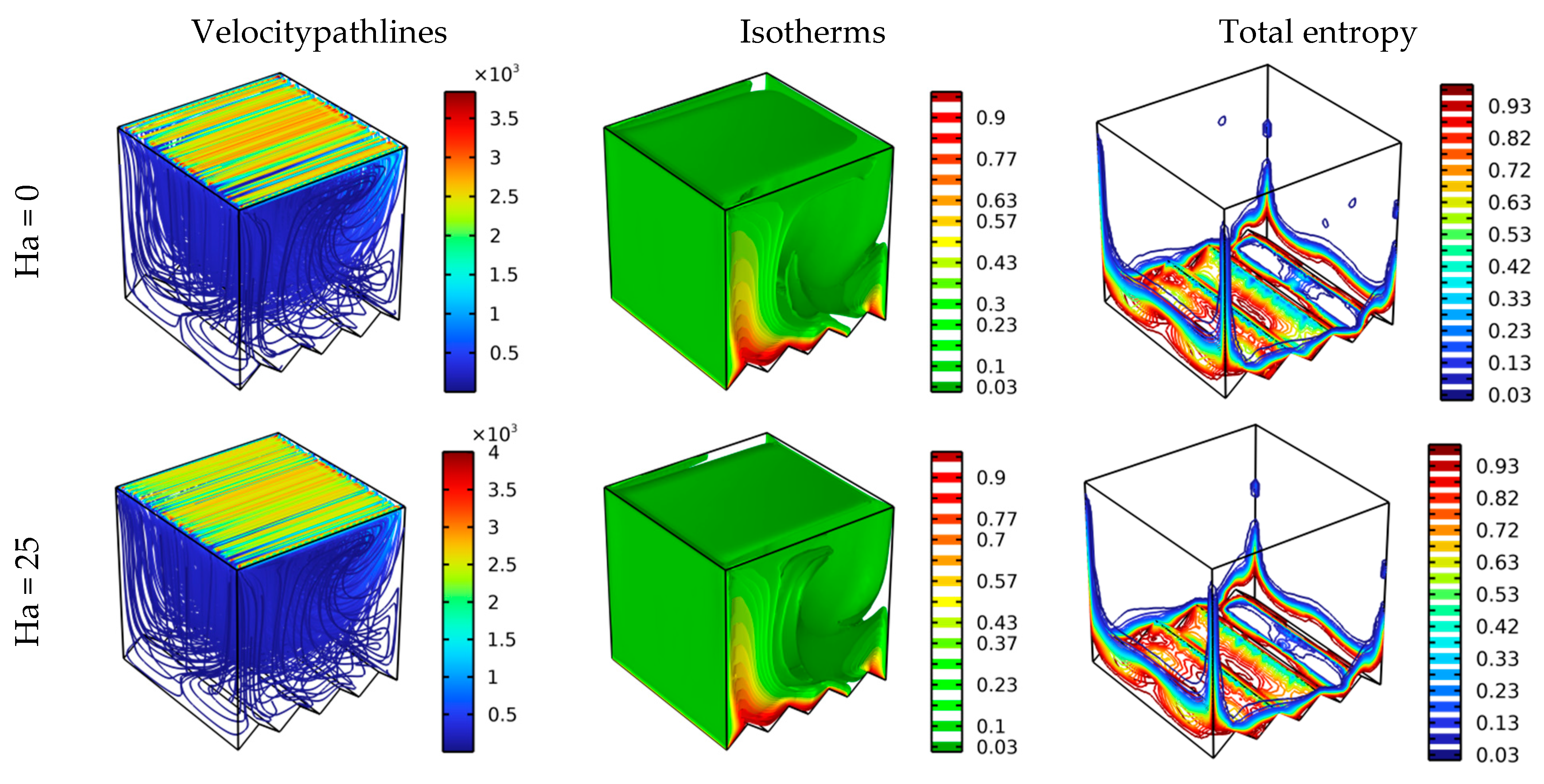
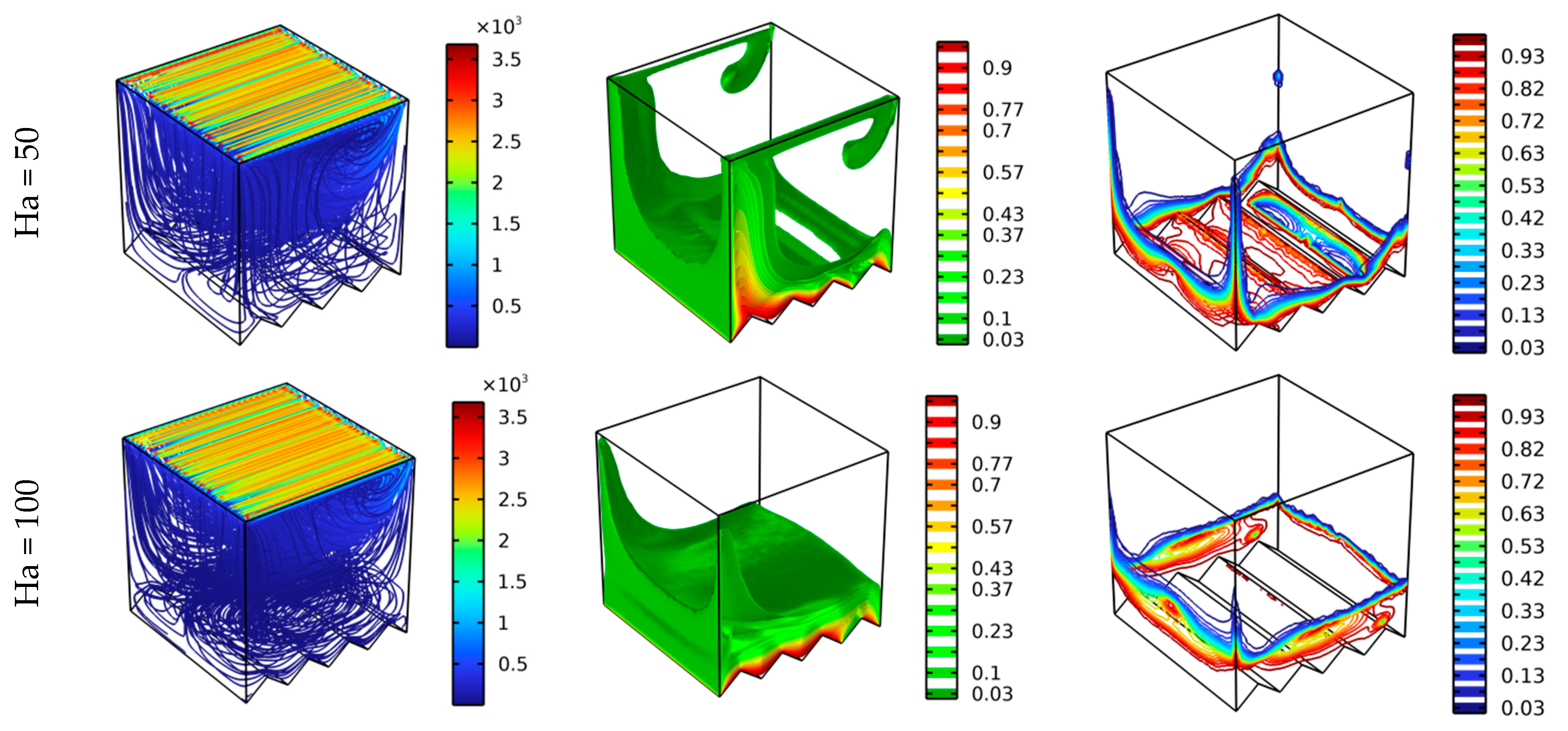
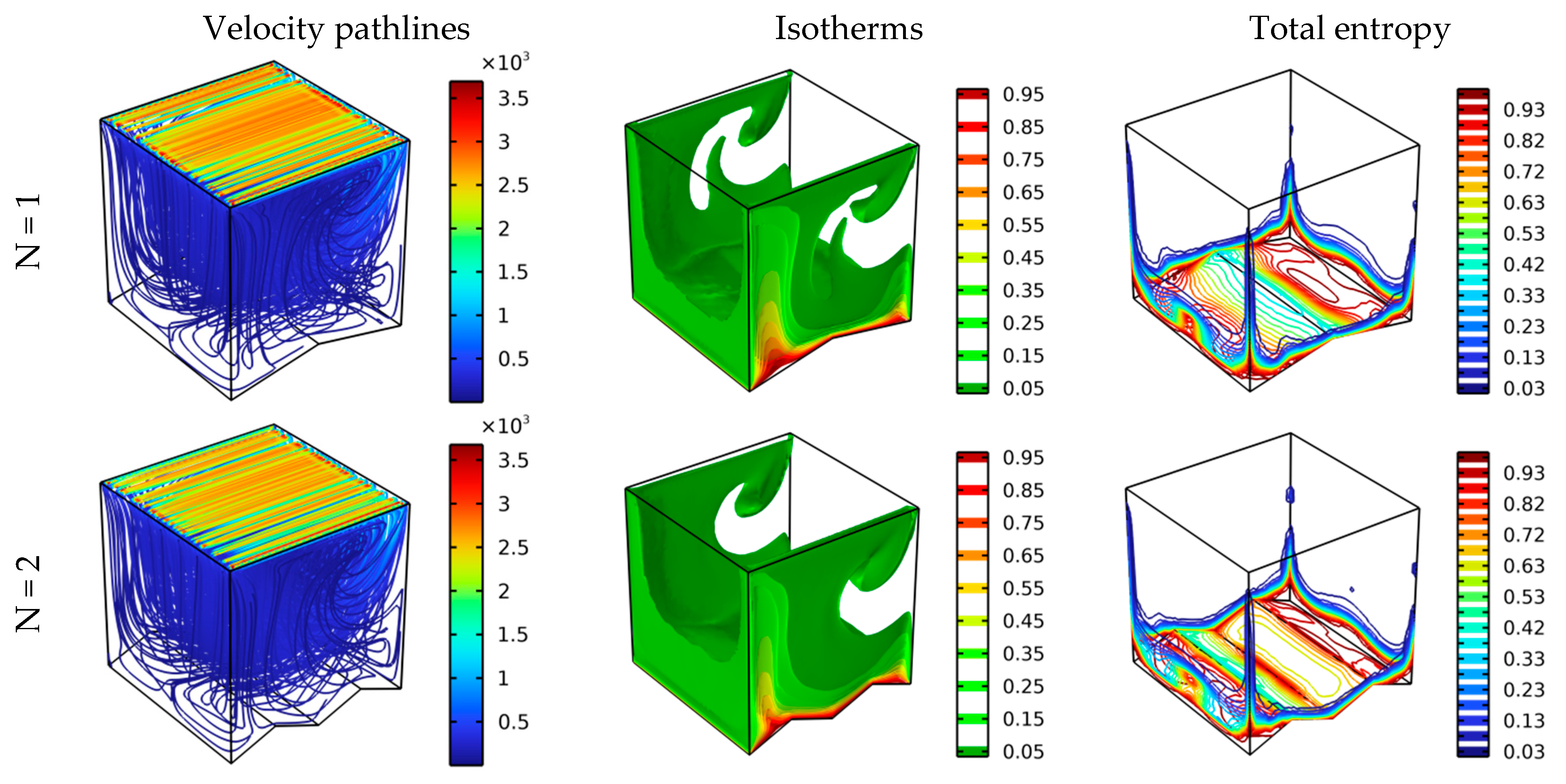
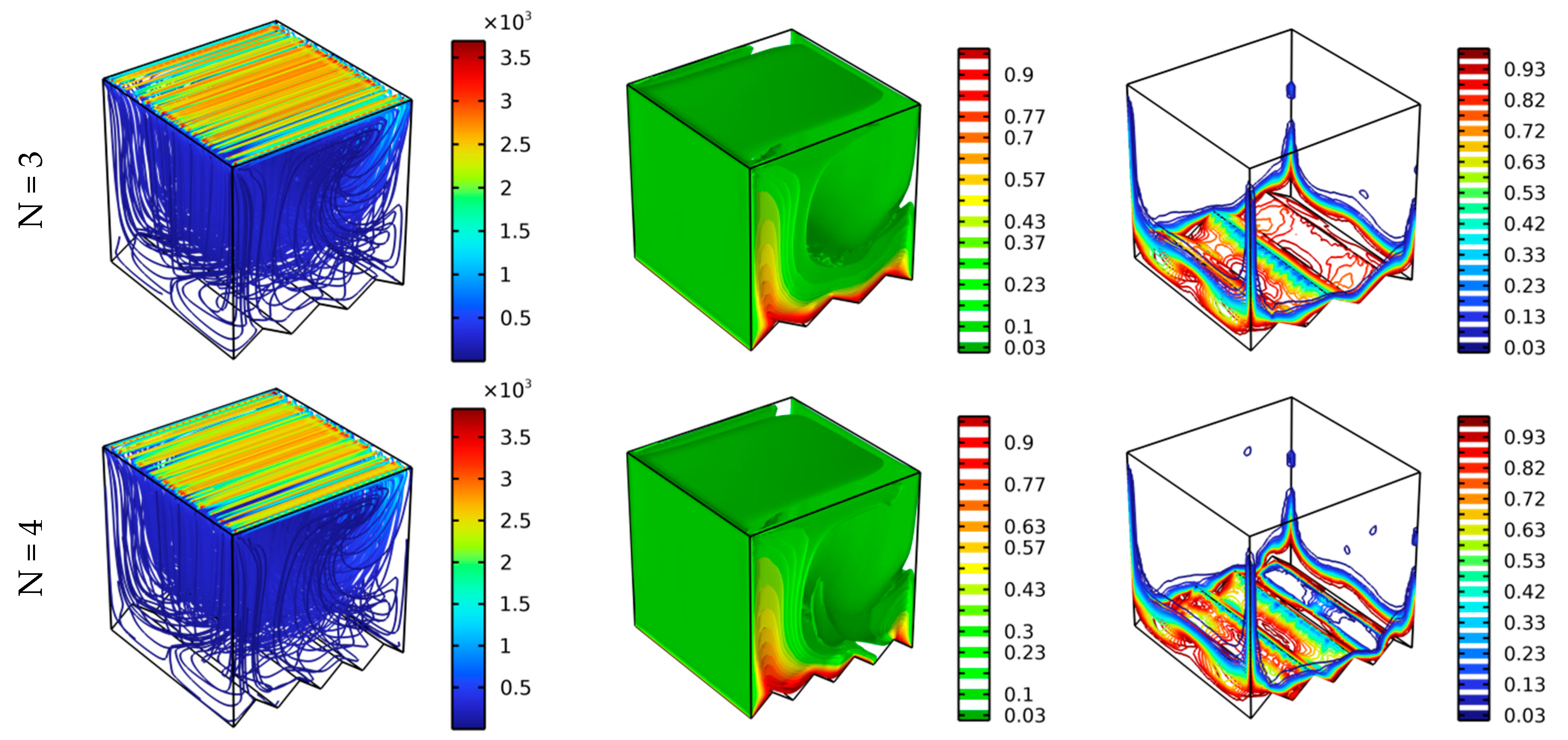


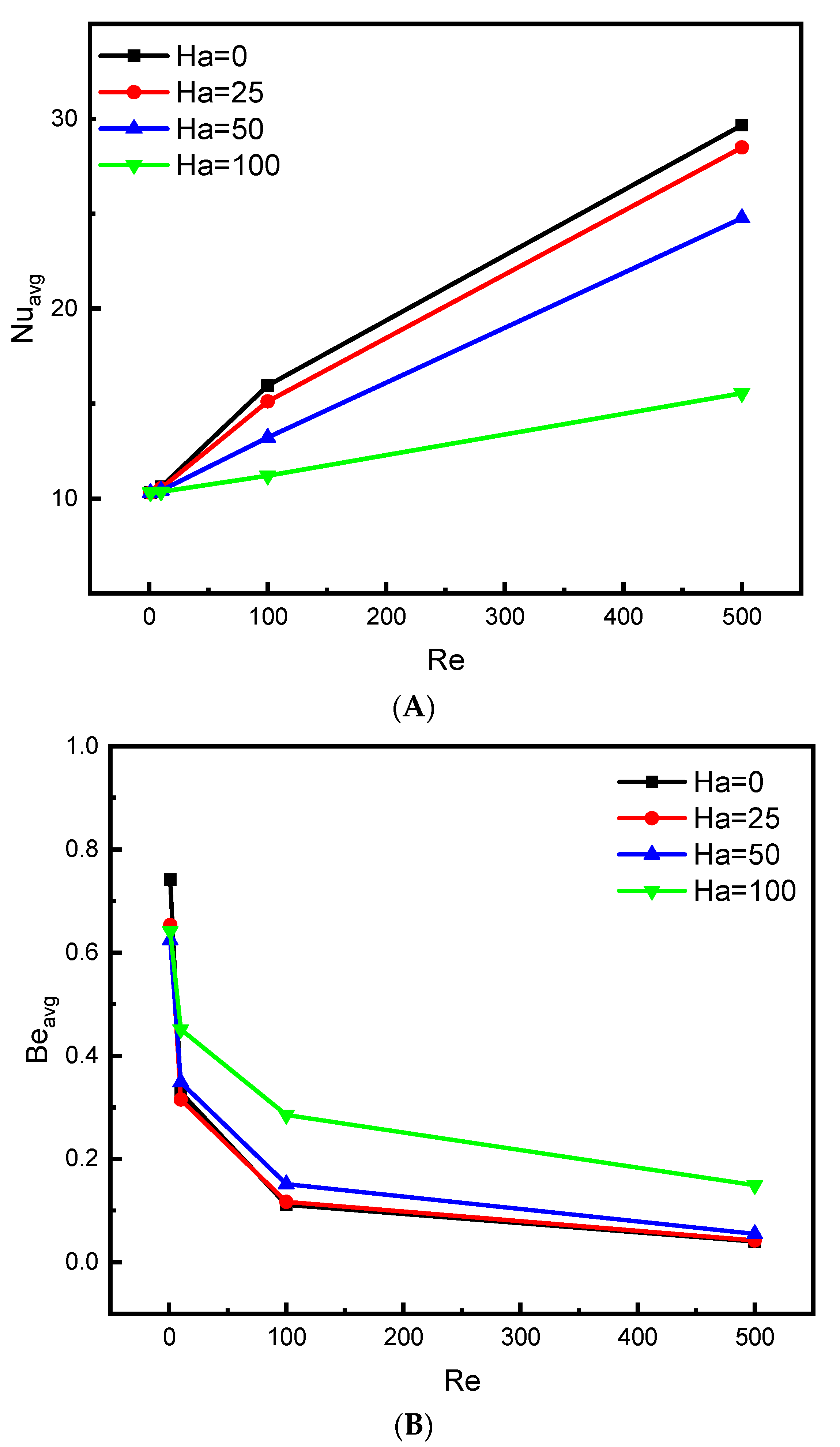
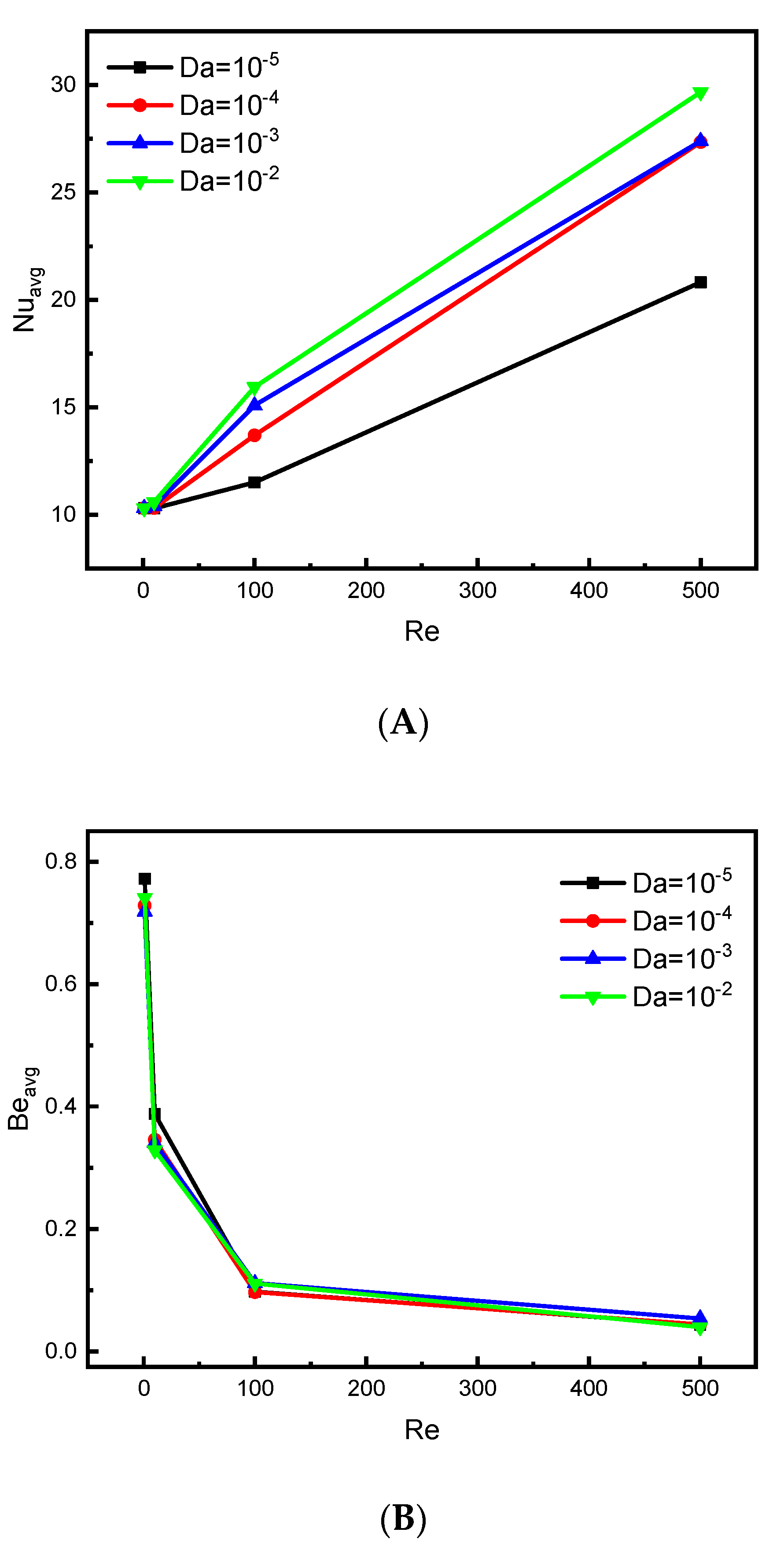

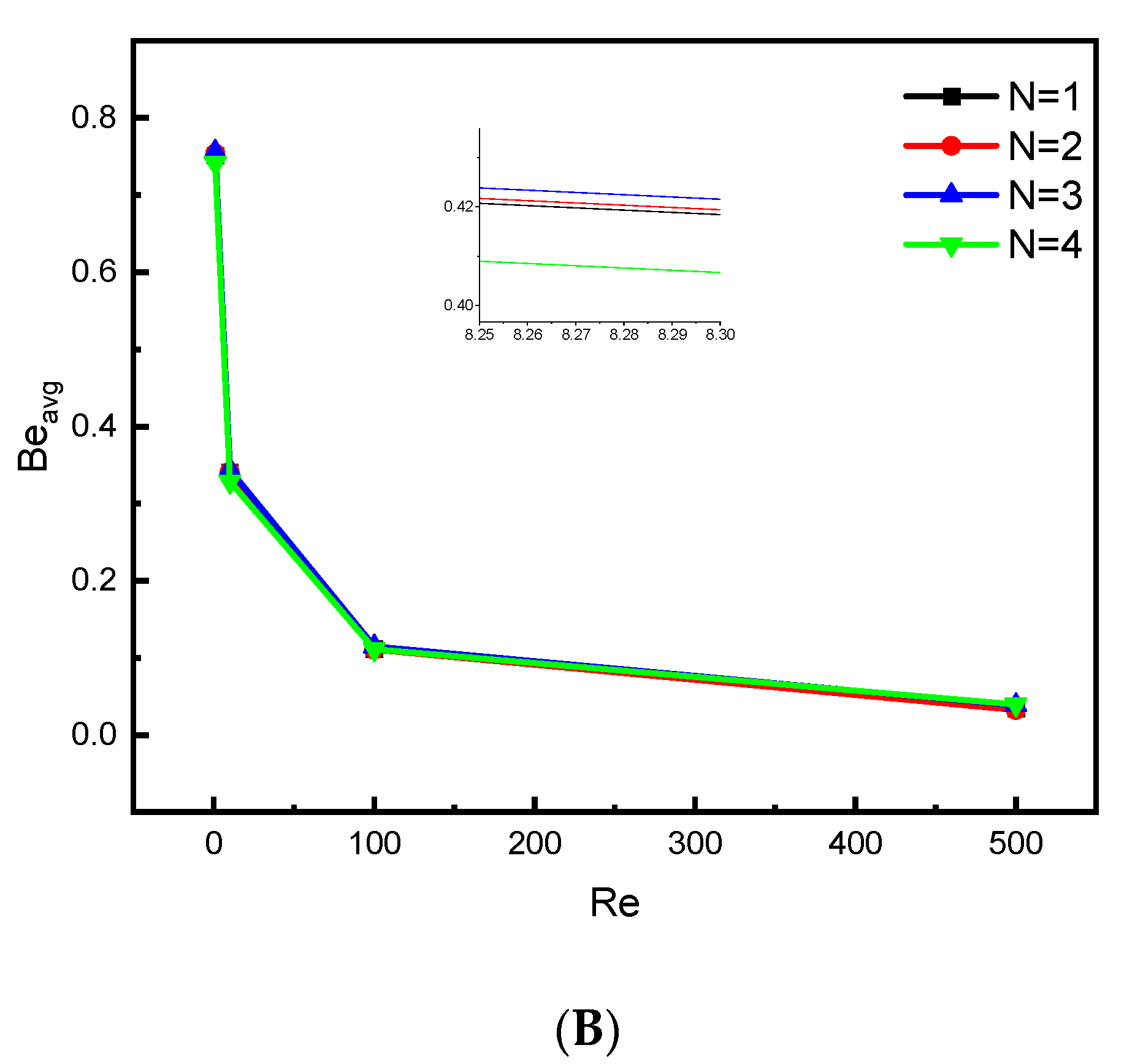
| Thermophysical Properties | Water | ||
|---|---|---|---|
| Density [ ] | 3970 | 8933 | |
| Specific heat [ | 765 | 385 | 4179 |
| Thermal conductivity | 40 | 400 | |
| Electrical conductivity [ |
| No. of Grid Elements | 6287 | 59,960 | 159,022 | 511,449 | 2,163,030 |
|---|---|---|---|---|---|
| Nuavg | 15,555 | 15,542 | 15,549 | 15,548 | 15,548 |
| Beavg | 0.14927 | 0.14852 | 0.14832 | 0.14832 | 0.14832 |
Publisher’s Note: MDPI stays neutral with regard to jurisdictional claims in published maps and institutional affiliations. |
© 2022 by the authors. Licensee MDPI, Basel, Switzerland. This article is an open access article distributed under the terms and conditions of the Creative Commons Attribution (CC BY) license (https://creativecommons.org/licenses/by/4.0/).
Share and Cite
Laidoudi, H.; Abderrahmane, A.; Saeed, A.M.; Guedri, K.; Weera, W.; Younis, O.; Mourad, A.; Marzouki, R. Irreversibility Interpretation and MHD Mixed Convection of Hybrid Nanofluids in a 3D Heated Lid-Driven Chamber. Nanomaterials 2022, 12, 1747. https://doi.org/10.3390/nano12101747
Laidoudi H, Abderrahmane A, Saeed AM, Guedri K, Weera W, Younis O, Mourad A, Marzouki R. Irreversibility Interpretation and MHD Mixed Convection of Hybrid Nanofluids in a 3D Heated Lid-Driven Chamber. Nanomaterials. 2022; 12(10):1747. https://doi.org/10.3390/nano12101747
Chicago/Turabian StyleLaidoudi, Houssem, Aissa Abderrahmane, Abdulkafi Mohammed Saeed, Kamel Guedri, Wajaree Weera, Obai Younis, Abed Mourad, and Riadh Marzouki. 2022. "Irreversibility Interpretation and MHD Mixed Convection of Hybrid Nanofluids in a 3D Heated Lid-Driven Chamber" Nanomaterials 12, no. 10: 1747. https://doi.org/10.3390/nano12101747
APA StyleLaidoudi, H., Abderrahmane, A., Saeed, A. M., Guedri, K., Weera, W., Younis, O., Mourad, A., & Marzouki, R. (2022). Irreversibility Interpretation and MHD Mixed Convection of Hybrid Nanofluids in a 3D Heated Lid-Driven Chamber. Nanomaterials, 12(10), 1747. https://doi.org/10.3390/nano12101747









